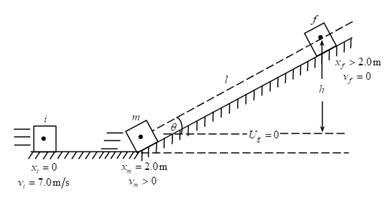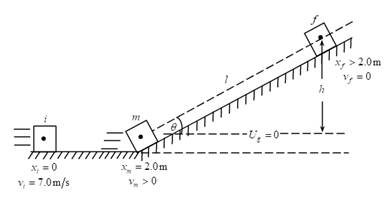
Concept explainers
(a)
The distance traveled by block along the incline plane.
(a)
Explanation of Solution
Given:
The mass of block is
The initial speed of block is
The coefficient of friction is
The angle of incline with the horizontal is
Formula used:
Write the expression for friction force along the incline.
Here,
Write the expression for thermal energy.
Here,
Substitute
Write the expression for change in potential energy.
Here,
Write the expression for change in kinetic energy.
Here,
Total energy of block is conserved at all points. Work done by external force is equal to the sum of change in gravitational potential energy, kinetic energy and thermal energy.
Write the expression of work done by external force.
Here,

There is no external force acting on the block; so, the work done by external force is zero.
Substitute
Substitute
Calculation:
Substitute
Conclusion:
Thus, the distance traveled by block along the incline is
(b)
The speed of the block when it has traveled half the distance in part (a).
(b)
Explanation of Solution
Given:
The mass of block is
The initial speed of block is
The coefficient of friction is
The angle of incline with the horizontal is
Formula used:
Write the expression for friction force along the incline.
Here,
Write the expression for thermal energy.
Here,
Substitute
Write the expression for change in potential energy.
Here,
Write the expression for change in kinetic energy.
Here,
Total energy of block is conserved at all points. Work done by external force is equal to the sum of change in gravitational potential energy, kinetic energy and thermal energy.
Write the expression of work done by external force.
Here,

There is no external force acting on the block; so, the work done by external force is zero.
Substitute
Substitute
For object velocity at halfway on incline plane:
Substitute
Substitute
Calculation:
Substitute
Conclusion:
Thus, the speed of the block when it has traveled half the distance in part (a)is
Want to see more full solutions like this?
Chapter 7 Solutions
Physics for Scientists and Engineers
- Tom reached a speed of 29 m/s in the downhill skiing competition. Suppose he left the slope at that speed and then slid freely along a horizontal surface. If the coefficient of kinetic friction between his feet and the ground was 0.27 and his final speed was half of his initial speed, find the distance he traveled?arrow_forwardAt Ted's request, Bill pushes the pizza box across the granite countertop towards Ted. When the box leaves Bill's hand it is sliding at 2.60 m/s. The box comes to rest over a distance of 110 cm. What is the coefficient of kinetic friction, uk, between the pizza box and the countertop? (Ignore air drag.)arrow_forwardAt an accident scene on a level road, investigators measure a car's skid mark to be 102m long. The accident was occurred on a rainy day, and the coefficient of kinetic friction was estimated to be 0.36. Use these data to determine the speed of the car when the driver slammed on (and locked) the brakes.arrow_forward
- A 91 kg block sliding horizontally across the floor has a coefficient of static friction of us 0.48 and a coefficient of kinetic friction of k = 0.29. If it was sliding at an initial speed of 2.5 m/s, how far will it travel before stopping?arrow_forwardIf the coefficient of kinetic friction between tires and dry pavement is 0.80, what is the shortest distance in which you can stop a car by locking the brakes when the car is traveling at 28.7 m>s (about 65 mi>h)?arrow_forwardA 12 kg block of ice slides down a ramp 10 m long, inclined at 18° to the horizontal. (a) If the coefficient of kinetic friction between the ice and the ramp is 0.10, what is the acceleration of the block of ice? (b) What is the final speed of the ice at the bottom of the ramp? 18°arrow_forward
- A man was originally walking at 1.5 m/s and then reaches a speed of 8.1 m/s in 2.4 s. He estimated that his coefficient of friction was 0.30. Was it above or below this value?arrow_forwardAt an accident scene on a level road, investigators measure a car's skid mark to be 93 m m long. It was a rainy day and the coefficient of friction was estimated to be 0.31. Use these data to determine the speed of the car when the driver slammed on (and locked) the brakes.arrow_forwardAn incline makes an angle of 30.0 degrees with the horizontal. (Static friction coefficent of the inclined surface = 0.4 and the kinetic friction coefficent is 0.1) A block must pass through the top of the incline with a velocity of 3.0 m/s. At what distance along the incline must you realeas the block?arrow_forward
- A skier is on a 25 degree slope and his mass is 80kg. If his constant velocity and the coefficient of kinetic friction between the ski and the snow is 9 m/s and 0.80, respectively, compute his velocity when he has skid 20m from his initial position and a drag force experienced by the skier equivalent to a magnitude of 0.6V^2.arrow_forwardA skier is on a 25° slope and his mass is 80kg. If his constant velocity and the coefficient of kinetic friction between the ski and the snow is 9 m/s and 0.80, respectively, compute his velocity when he has skid 20m from his initial position and a drag force experienced by the skier equivalent to a magnitude of 0.6V^2.arrow_forwardA block of mass 4 kg is pushed with an initial speed of 1.0 m/ s up an inclined plane raised 20° above the horizontal. If the coefficients of static and kinetic friction are 0.3 and 0.1 respectively , how far along the plane does the ball slide before stopping?arrow_forward
 Glencoe Physics: Principles and Problems, Student...PhysicsISBN:9780078807213Author:Paul W. ZitzewitzPublisher:Glencoe/McGraw-Hill
Glencoe Physics: Principles and Problems, Student...PhysicsISBN:9780078807213Author:Paul W. ZitzewitzPublisher:Glencoe/McGraw-Hill Physics for Scientists and Engineers: Foundations...PhysicsISBN:9781133939146Author:Katz, Debora M.Publisher:Cengage Learning
Physics for Scientists and Engineers: Foundations...PhysicsISBN:9781133939146Author:Katz, Debora M.Publisher:Cengage Learning

